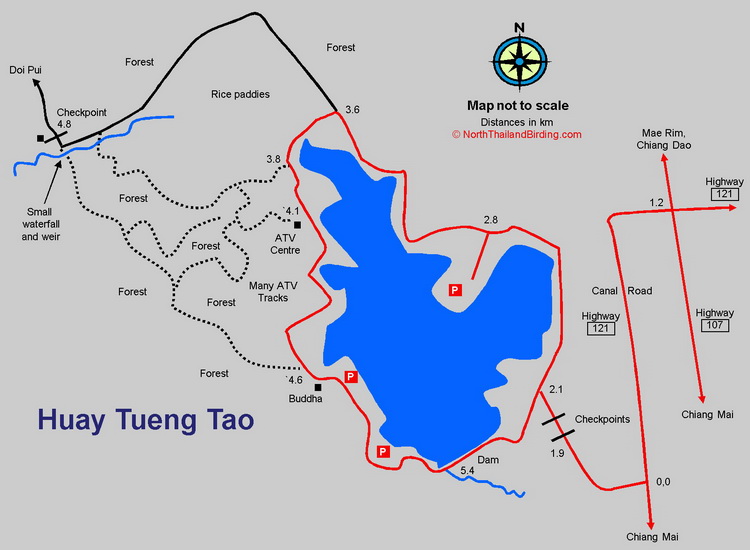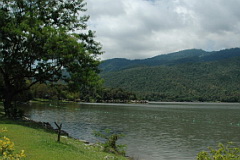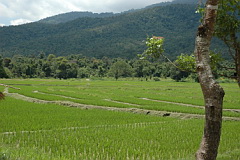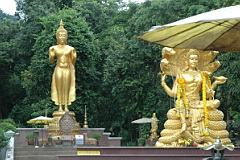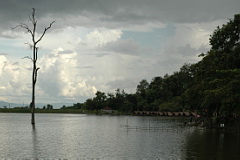Overview
Although not a protected area, Huay Tueng Tao offers an easy short day's birding conveniently close to Chiang Mai. The area belongs to the military, is sometimes used for training exercises, and a few areas have restricted access. As it is used primarily as a recreation area, it can be busy with fishermen, picnickers, runners, cyclists, ATV riders and zip-liners at weekends and holidays. Birders arriving early should have the place to themselves. Being directly adjacent to the Doi Suthep-Pui National Park a number of low altitude forest species can be found here, together with a collection of commoner wintering migrants. Over the years a large number of species have turned up, but continued touristic 'improvements' and developments are slowly degrading the habitats and their attraction to wildlife. Huay Tueng Tao is one place demonstrating the quirks of the transliteration of Thai - driving to and around the lake, in addition to the 'correct' spelling, one finds Huey Tueng Tao, Hoey Tueng Tao, Huai Tung Thao, Huay Tueng Thao and Huay Tung Tao. Information on this page verified/accurate as of 12 Jun 2018.
|
AccessHuay Tueng Tao lies 11 km north of Chiang Mai city, and can be accessed via either Highway 107 or Highway 121. From central Chiang Mai take Highway 107 directly north from the city moat in the direction of Mae Rim and Chiang Dao. After about 8.5 km from the moat, at the Highway 121 intersection, turn left. This is the Canal Road, heading back toward Chiang Mai, with the entrance to Huay Tueng Tao found on the right side 1.2 km from the intersection. Alternatively, if coming from Doi Suthep or the western side of Chiang Mai, take Highway 121 (Canal Road) directly northward off the Doi Suthep road (Highway 1004) 2.2 km from the northwest corner of the city moat. The entrance to Huay Tueng Tao is well sign posted 7 km from the turn onto Highway 121. Once on the entrance road, it's 1.9 km to the entrance checkpoint where a 50 Baht fee is levied. For some bizarre reason the ticket will be checked 100 metres further down the road at another checkpoint. Officially the entrance opens at 07:00, but access is not closed, so earlier entry is possible. At 2.1 km the 3.8 km loop road around the lake starts. This road can be driven in either direction, though beware runners and cyclists treat it as an exercise track in an anti-clockwise direction. At 3.6 km a dirt track heads off around the rice paddies for 2.2 km to arrive at the back entrance to Doi Suthep-Pui National Park where there's a very small waterfall, a weir and a checkpoint. Only with a 4x4 vehicle is it possible to continue up the mountain dirt road to Doi Pui. Distances marked on the map are measured in an anti-clockwise direction. Accommodation and FacilitiesFood and drinks are available from the large number of rustic eating outlets spaced around the lake, which also rent floating shaded eating areas for a small fee, and make a good place for a siesta at lunchtime. No accommodation is available being so close to the city. BirdingLoop Road and Lake Early morning, before the crowds, a fair number of species can be seen simply walking around the lake. The forest edge on the eastern side is more open but holds interesting species such as Red-billed Blue Magpie. The lake itself is usually devoid of birds due to constant clearance of the edges and disturbance from fishermen, although the northern, shallow end holds Baikal Bush Warbler and Thick-billed Warbler in the winter. Resident species that can be found include White-breasted Waterhen, Lesser Whistling Duck and Wire-tailed Swallow - usually along the western edge. In winter, any area with trees holds Taiga Flycatcher and Yellow-browed Warbler. |
Rice paddies
At the northern end of the lake a reasonably size area of rice paddies can attract different species depending on the season. These paddies are least interesting when the rice is being grown, as pesticide use kills off most of the food supply for wildlife. However during the cool, winter season these paddies lie fallow and the stubble can attract a very different set of species to the lake edge, that will likely include Indochinese Bush Lark, Paddyfield Pipit, Lanceolated Warbler, Red Collared Dove, Amur Stonechat, Long-tailed Shrike and Pin-tailed Snipe, with Siberian Rubythroat in the edges.
Forest Trails
The forest area behind the, lately disused, ATV rental area, backing onto the Doi Suthep-Pui National Park is a maze of ATV trails which can be explored for seeking out forest birds. Probably the easiest access is to walk 100 metres northward past the Buddha shrine, and take the obvious wide trail into the forest. There are so many tracks and trails in this area, but the area can be explored without getting lost, as heading downhill will always return to the lake. A variation on this is to enter the forest at the northern end by the Doi Pui checkpoint and head back, the one kilometre, toward the shrine. At the checkpoint simply walk across the weir (easy in the dry season) and follow the trail in the general direction of the lake. Forest species include Red-billed Blue Magpie, White-crested Laughingthrush and Great Iora. The small waterfall and weir can be very good in the dry season for puddling butterflies.
Checklist
Checklist of species.
Gallery
Additional images from Huay Tueng Tao available in the Thailand Travel gallery.
Sunrise and Sunset
Detailed sunrise and sunset times.

